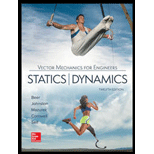
Concept explainers
A slender rod of length l and mass m is pivoted about a point C located at a distance b from its center G. It is released from rest in a horizontal position and swings freely. Determine (a) the angular velocity of the rod as it passes through a vertical position if b = l/2, (b) the distance b for which the angular velocity of the rod as it passes through a vertical position is maximum, (c) the corresponding values of its angular velocity and of the reaction at C using the value of b calculated.
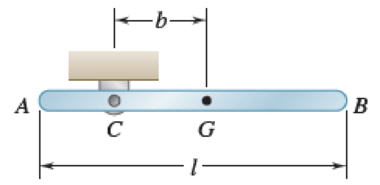
Fig. P17.16
(a)
Find the angular velocity of the rod when
Answer to Problem 17.16P
The angular velocity of the rod when
Explanation of Solution
Show the free-body diagram of the given condition as in Figure 1.
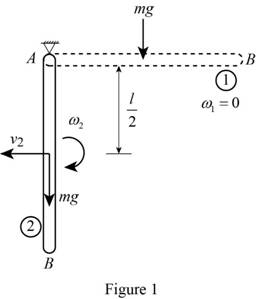
Find the mass moment of inertia of the slender rod
Here, the mass of the slender rod is m and the length of the slender rod is l.
Position 1 (Horizontal position):
The angular velocity
The velocity
Find the total kinetic energy in the horizontal position
Substitute 0 for
Positon 2 (Vertical position):
Find the velocity of the slender rod
Find the total kinetic energy in the vertical position
Substitute
Find the work done
Here, the acceleration due to gravity is g.
Write the equation of work and energy for the system using the equation.
Substitute 0 for
Therefore, the angular velocity of the rod when
(b)
Find the distance b for which the angular velocity of rod as it passes through a vertical position is maximum.
Answer to Problem 17.16P
The distance b for which the angular velocity of the rod is maximum in vertical position is
Explanation of Solution
Position 1 (Horizontal position):
Show the free-body diagram of the horizontal position as in Figure 2.
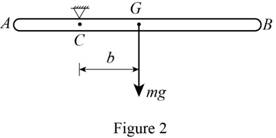
Find the mass moment of inertia of the slender rod
The angular velocity
The velocity
Find the total kinetic energy in the horizontal position
Substitute 0 for
The elevation (h) of the pivot C is zero.
Find the total potential energy
Substitute 0 for h.
Positon 2 (Vertical position):
Show the free-body diagram of the vertical position as in Figure 3.

Find the velocity of the slender rod
Find the total kinetic energy in the vertical position
Substitute
The elevation of the pivot C is
Find the total potential energy
Substitute b for h.
Write the equation of conservation of energy using the equation.
Substitute 0 for
Integrate the angular velocity with respect to b and equate to zero.
Therefore, the distance b for which the angular velocity of the rod is maximum in vertical position is
(c)
Find the angular velocity where the vertical position is maximum and the reaction at pivot C.
Answer to Problem 17.16P
The angular velocity corresponding to the maximum vertical position is
The reaction at pivot C is
Explanation of Solution
Refer to the calculation of part (b):
Substitute
Therefore, the angular velocity corresponding to the maximum vertical position is
Show the free-body diagram of the slender rod as in Figure 4.
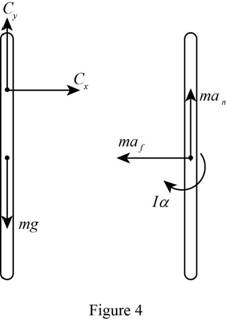
Find the normal acceleration
Substitute
The value of tangential acceleration is
Resolve the vertical component of forces.
Take moment about point C as follows;
Therefore,
Resolve the horizontal component of forces.
Find the resultant reaction at point C using the relation.
Substitute 0 for
Therefore, the reaction at pivot C is
Want to see more full solutions like this?
Chapter 17 Solutions
VECTOR MECH. FOR EGR: STATS & DYNAM (LL
Additional Engineering Textbook Solutions
Automotive Technology: Principles, Diagnosis, And Service (6th Edition) (halderman Automotive Series)
BASIC BIOMECHANICS
Database Concepts (8th Edition)
Concepts Of Programming Languages
Mechanics of Materials (10th Edition)
Thermodynamics: An Engineering Approach
- A piston–cylinder device contains 50 kg of water at 250 kPa and 25°C. The cross-sectional area of the piston is 0.1 m2. Heat is now transferred to the water, causing part of it to evaporate and expand. When the volume reaches 0.26 m3, the piston reaches a linear spring whose spring constant is 100 kN/m. More heat is transferred to the water until the piston rises 20 cm more. NOTE: This is a multi-part question. Once an answer is submitted, you will be unable to return to this part. Determine the final pressure and temperature. The final pressure is kPa. The final temperature is ºC. Find the work done during the processarrow_forwardA garden hose attached with a nozzle is used to fill a 20-gal bucket. The inner diameter of the hose is 1 in and it reduces to 0.53 in at the nozzle exit. The average velocity in the hose is 8 ft/s and the density of water is 62.4 lbm/ft3. NOTE: This is a multi-part question. Once an answer is submitted, you will be unable to return to this part. Determine the volume and mass flow rates of water through the hose. The volume flow rate of water through the hose is ft3/s. The mass flow rate of water through the hose is lbm/s. The change in time? What is the exit velocity?arrow_forwardA 23-ft3 rigid tank initially contains saturated refrigerant-134a vapor at 160 psia. As a result of heat transfer from the refrigerant, the pressure drops to 50 psia. NOTE: This is a multi-part question. Once an answer is submitted, you will be unable to return to this part. Determine the final temperature. Use data from refrigerant tables. The final temperature is ºF.arrow_forward
- A 23-ft3 rigid tank initially contains saturated refrigerant-134a vapor at 160 psia. As a result of heat transfer from the refrigerant, the pressure drops to 50 psia. NOTE: This is a multi-part question. Once an answer is submitted, you will be unable to return to this part. Determine the heat transfer. The heat transfer is Btu.arrow_forwardThe shaft shown in the figure below is subjected to axial loads as illustrated. The diameters of segments AB, BC, and CD are 20mm, 25mm, and 15mm, respectively. If the modulus of elasticity of the material is 610 MPa. Determine the change of A to D lengtharrow_forwardDetermine the final pressure and temperature. The final pressure is kPa. The final temperature is ºC.arrow_forward
- Air enters the 1-m2 inlet of an aircraft engine at 100 kPa and 20°C with a velocity of 184 m/s. Determine the volume flow rate, in m3/s, at the engine’s inlet and the mass flow rate, in kg/s, at the engine’s exit. The gas constant of air is R = 0.287 kPa·m3/kg·K. The volume flow rate at the engine’s inlet m3/s. The mass flow rate at the engine’s exit is kg/s.arrow_forwardThe ventilating fan of the bathroom of a building has a volume flow rate of 33 L/s and runs continuously. If the density of air inside is 1.20 kg/m3, determine the mass of air vented out in one day. The mass of air is kg.arrow_forwardA steady-flow compressor is used to compress helium from 15 psia and 70°F at the inlet to 200 psia and 600°F at the outlet. The outlet area and velocity are 0.01 ft2 and 100 ft/s, respectively, and the inlet velocity is 53 ft/s. Determine the mass flow rate and the inlet area. The gas constant of helium is R = 2.6809 psia·ft3/lbm·R. The mass flow rate is lbm/s. The inlet area is ft2.arrow_forward
- 1. The maximum and minimum stresses as well as the shear stress seen subjected the piece in plane A-A. Assume it is a cylinder with a diameter of 12.7mm 2. Draw the Mohr circle for the stress state using software. 3. Selection of the material for the prosthesis, which must be analyzed from the point of safety and cost view.arrow_forwardMarrow_forward× Your answer is incorrect. (Manometer) Determine the angle 0 of the inclined tube shown in figure below if the pressure at A is 1 psi greater than that at B. 1ft SG=0.61 十 A Ꮎ 1ft SG=1.0 8.8 ft 0 = Hi 15.20 deg Airarrow_forward
 Elements Of ElectromagneticsMechanical EngineeringISBN:9780190698614Author:Sadiku, Matthew N. O.Publisher:Oxford University Press
Elements Of ElectromagneticsMechanical EngineeringISBN:9780190698614Author:Sadiku, Matthew N. O.Publisher:Oxford University Press Mechanics of Materials (10th Edition)Mechanical EngineeringISBN:9780134319650Author:Russell C. HibbelerPublisher:PEARSON
Mechanics of Materials (10th Edition)Mechanical EngineeringISBN:9780134319650Author:Russell C. HibbelerPublisher:PEARSON Thermodynamics: An Engineering ApproachMechanical EngineeringISBN:9781259822674Author:Yunus A. Cengel Dr., Michael A. BolesPublisher:McGraw-Hill Education
Thermodynamics: An Engineering ApproachMechanical EngineeringISBN:9781259822674Author:Yunus A. Cengel Dr., Michael A. BolesPublisher:McGraw-Hill Education Control Systems EngineeringMechanical EngineeringISBN:9781118170519Author:Norman S. NisePublisher:WILEY
Control Systems EngineeringMechanical EngineeringISBN:9781118170519Author:Norman S. NisePublisher:WILEY Mechanics of Materials (MindTap Course List)Mechanical EngineeringISBN:9781337093347Author:Barry J. Goodno, James M. GerePublisher:Cengage Learning
Mechanics of Materials (MindTap Course List)Mechanical EngineeringISBN:9781337093347Author:Barry J. Goodno, James M. GerePublisher:Cengage Learning Engineering Mechanics: StaticsMechanical EngineeringISBN:9781118807330Author:James L. Meriam, L. G. Kraige, J. N. BoltonPublisher:WILEY
Engineering Mechanics: StaticsMechanical EngineeringISBN:9781118807330Author:James L. Meriam, L. G. Kraige, J. N. BoltonPublisher:WILEY





